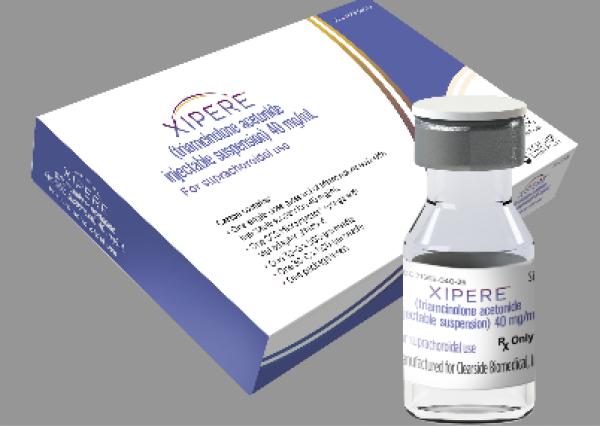Triamcinolone Ophthalmic Side Effects
Medically reviewed by Drugs.com. Last updated on Jul 15, 2025.
Applies to triamcinolone ophthalmic: intraocular suspension.
Precautions
Your eye doctor will want to check your progress at regular visits, especially during the first few days after you receive this medicine, to make sure this medicine is working properly and to check for unwanted effects.
Serious eye problems (eg, cataracts, glaucoma, detached retina, eye infection or swelling) may occur after receiving this medicine. Check with your eye doctor right away if you have a change in vision or the eye becomes red, sensitive to light, or painful. Also, tell your doctor if you feel an increased pressure in the eye.
This medicine may cause endocrine problems (eg, HPA axis suppression, Cushing syndrome, high blood sugar). These problems may occur if you are receiving this medicine for a long time or if you suddenly stopped receiving it. Talk with your doctor if you have any concerns about this.
Serious side effects
Along with its needed effects, triamcinolone ophthalmic may cause some unwanted effects. Although not all of these side effects may occur, if they do occur they may need medical attention.
Check with your doctor or nurse immediately if any of the following side effects occur while taking triamcinolone ophthalmic:
More common side effects
- blindness
- blurred vision
- change in vision
- eye pain
- increased pressure in the eye
- loss of vision
- seeing flashes or sparks of light
- seeing floating spots before the eyes, or a veil or curtain appearing across part of vision
Less common side effects
- bloody eye
- change in color vision
- difficulty seeing at night
- drooping upper eyelids
- increased sensitivity of the eyes to sunlight
- painful irritation of the clear front part of the eye
- swelling or redness of the eye or inside of the eyelids
- tearing
Incidence not known
- backache
- darkening of the skin
- diarrhea
- dizziness
- dry mouth
- facial hair growth in females
- fainting
- flushed, dry skin
- fractures
- fruit-like breath odor
- full or round face, neck, or trunk
- increased hunger
- increased thirst or urination
- irritability
- loss of appetite
- loss of sexual desire or ability
- menstrual irregularities
- mental depression
- muscle wasting
- nausea
- sweating
- trouble breathing
- unexplained weight loss
- unusual tiredness or weakness
- vomiting
Other side effects
Some side effects of triamcinolone ophthalmic may occur that usually do not need medical attention. These side effects may go away during treatment as your body adjusts to the medicine. Also, your health care professional may be able to tell you about ways to prevent or reduce some of these side effects.
Check with your health care professional if any of the following side effects continue or are bothersome or if you have any questions about them:
More common side effects
- headache
See also:
For healthcare professionals
Applies to triamcinolone ophthalmic: intraocular suspension, intravitreal suspension.
General adverse events
The most commonly reported side effects were elevated intraocular pressure and cataract progression.[Ref]
Ocular
- Frequency not reported: Endophthalmitis (infectious and non-infectious), hypopyon, injection site reactions (described as blurring and transient discomfort), glaucoma, vitreous floaters, detachment of retinal pigment epithelium, optic disc vascular disorder, eye inflammation, conjunctival hemorrhage, visual acuity reduced, exophthalmos[Ref]
Hypersensitivity
- Frequency not reported: Anaphylactoid reaction, anaphylaxis, angioedema[Ref]
Cardiovascular
- Frequency not reported: Elevation in blood pressure, bradycardia, cardiac arrest, cardiac arrhythmia, cardiac enlargement, circulatory collapse, congestive heart failure, fat embolism, hypertrophic cardiomyopathy in premature infants, myocardial rupture following recent myocardial infarction, syncope, tachycardia, thromboembolism, thrombophlebitis, vasculitis[Ref]
Dermatologic
- Frequency not reported: Acne, allergic dermatitis, cutaneous and subcutaneous atrophy, dry scalp, edema, facial erythema, hyper or hypopigmentation, increased sweating, petechiae, ecchymosis, rash, sterile abscess, striae, suppressed reactions to skin tests, thin fragile skin, thinning scalp hair, urticaria[Ref]
Endocrine
- Frequency not reported: Alteration in glucose tolerance, abnormal fat deposits, decreased carbohydrate tolerance, development of Cushingoid state, hirsutism, manifestations of latent diabetes mellitus and increased requirements for insulin or oral hypoglycemic agents in diabetics, menstrual irregularities, moon facies, secondary adrenocortical and pituitary unresponsiveness (particularly in times of stress, as in trauma, surgery or illness), suppression of growth in children[Ref]
Gastrointestinal
- Frequency not reported: Abdominal distention, hiccups, malaise, nausea, pancreatitis, peptic ulcer with possible perforation and hemorrhage, ulcerative esophagitis[Ref]
Metabolic
- Frequency not reported: Fluid retention, increased appetite, weight gain, potassium loss, hypokalemic alkalosis, negative nitrogen balance due to protein catabolism[Ref]
Musculoskeletal
- Frequency not reported: Aseptic necrosis of femoral and humeral heads, Charcot-like arthropathy, loss of muscle mass, muscle weakness, osteoporosis, pathologic fracture of long bones, steroid myopathy, tendon rupture, vertebral compression fractures[Ref]
Nervous system
- Frequency not reported: Arachnoiditis, convulsions, headache, increased intracranial pressure with papilledema (pseudo-tumor cerebri) usually following discontinuation of treatment, insomnia, meningitis, neuritis, neuropathy, paraparesis/paraplegia, paresthesia, sensory disturbances, vertigo[Ref]
Genitourinary
- Postmarketing reports: Alteration in motility and number of spermatozoa[Ref]
Hepatic
- Frequency not reported: Elevation in serum liver enzymes levels (usually reversible upon discontinuation), hepatomegaly[Ref]
Other
- Frequency not reported: Impaired wound healing[Ref]
Psychiatric
- Frequency not reported: Behavioral and mood changes, depression, emotional instability, euphoria[Ref]
Respiratory
- Frequency not reported: Pulmonary edema[Ref]
References
1. (2007) "Product Information. Triesence (triamcinolone ophthalmic)." Alcon Laboratories Inc
More about triamcinolone ophthalmic
- Check interactions
- Compare alternatives
- Reviews (1)
- Dosage information
- During pregnancy
- Drug class: ophthalmic steroids
- Breastfeeding
- En español
Patient resources
Other brands
Professional resources
Other brands
Related treatment guides
Further information
Triamcinolone ophthalmic side effects can vary depending on the individual. Always consult your healthcare provider to ensure the information displayed on this page applies to your personal circumstances.
Note: Medication side effects may be underreported. If you are experiencing side effects that are not listed, submit a report to the FDA by following this guide.

